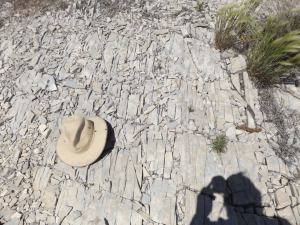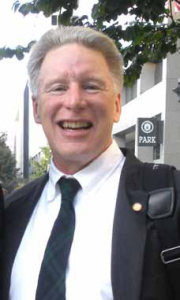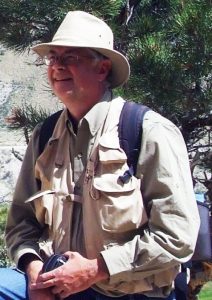ABSTRACT: Comparing Natural Fracture Systems in Reservoirs of the San Juan, Piceance, Raton, and Green River Basins
John C. Lorenz and Scott P. Cooper, FractureStudies LLC


Reservoirs in the San Juan, Piceance, Raton, and Green River basins have microdarcy-scale matrix permeabilities, yet the permeability of the matrix-fracture systems, measured by well tests, is typically in the millidarcy range and highly anisotropic. The dichotomy is the result of permeability enhancement and control by natural-fracture systems. Well-developed natural fractures of several types have been documented by image logs, outcrop studies, and by cores taken from even the deeper wells, but not all fracturing creates economic reservoirs.
The most common fractures are vertical extension fractures, filled or partially filled with quartz and calcite and oriented normal to basin-margin thrust fronts. Reservoirs in the middles of basins and away from faults and folds typically contain regional fractures with spacings on the order of several feet. Single sets of extension fractures enhance permeability in only one direction, creating highly anisotropic drainage ellipses, but multiple sets of extension fractures may be superimposed over the course of geologic time.
Extension fractures have been locally reactivated in shear and enhanced where they overlie faults, and such reactivated systems have been productive targets. Average fracture spacing may be less than a foot in these settings, and shear reactivation props them open. Reservoirs near overthrust basin margins locally contain conjugate strike-slip or even thrust-oriented shear fractures. Conjugate fractures offer potentially rewarding, interconnected fracture systems.
Stimulating and producing fractured reservoirs must be done carefully since hydraulic-fracture stimulations can damage natural-fracture permeabilities, and since production-related changes in the in situ stresses can close fracture apertures. Shear on critically-stressed fractures during stress changes can crush the fracture bridging and severely reduce fracture permeability. The three attempts to stimulate these reservoirs with nuclear explosions in the 1960s and 1970s offer a cautionary tale of natural-fracture damage.
BIOGRAPHY
John C. Lorenz, PhD

Lorenz earned an undergraduate BA, with a double major in geology and in anthropology, from Oberlin College in 1972. After serving in the Peace Corps, Morocco, he earned on his MSc, on the Moroccan Triassic, at the University of South Carolina (1975), and PhD, on Cretaceous strata in Libya and Montana, at Princeton University (1981). Lorenz has worked for the US Geological Survey in Louisiana and New Mexico, and for Sandia National Laboratories where he was the geologist for the tight-gas Multiwell Experiment in the Piceance basin. Lorenz has been a consultant, specializing in fractured reservoir characterization and effects, since 2007.
Lorenz served as the elected Editor (2001-2004) and President (2009-2010) of the American Association of Petroleum Geologists. As president he supported the advancement of the geosciences and their applications to hydrocarbon-related problems. His published papers on natural and induced fractures in reservoirs that range geographically from the Lisburne Limestone in Alaska to the Spraberry Formation in Texas. These papers and presentations have been awarded the AAPG Levorsen and Jules Braunstein awards. He has worked closely with the oil and gas industry on problems involving reservoir dimensions and in situ permeability, gaining extensive hands-on experience with core analysis and fieldwork. He has led field trips, presented core workshops, and taught short courses for the industry-oriented geological community.
Scott P. Cooper, M.S.

Cooper earned a Bachelor of Science degree in geology from the South Dakota School of Mines (1997), under Dr. Alvis Lisenbee and Dr. James Fox. He received his Master of Science in geology from the New Mexico Institute of Mining and Technology (2000) working with graduate research and academic advisors Dr. Laurel Goodwin and Dr. John Lorenz; the thesis topic was fracture characterization and modeling of Teapot Dome a basement-cored anticline in central Wyoming.
Cooper was a Senior Member of the Technical Staff at Sandia National Laboratories, a Department of Energy Research Laboratory, working on projects related to outcrop and subsurface fracture studies with applications to reservoir characterization, production and CO2 sequestration. He has been working in partnership with Dr. John Lorenz since 2008 at FractureStudies LLC on naturally fractured reservoir characterization projects around the world.
Cooper is an American Association of Petroleum Geologists, Division of Professional Affairs Certified Petroleum Geologist (#6123). He has published papers highlighting outcrop and subsurface fractures studies from Wyoming, Utah, Colorado, New Mexico, Texas and beyond. He has also led numerous field trips and taught short courses for the oil and gas industry throughout his career. Detailed descriptions of projects, published papers, and links to open-file reports and papers are available at www.fracturestudies.com.
SCHEDULE
- 5:30pm – Social
- 6:00pm – Dinner
- 6:30pm – Lecture

